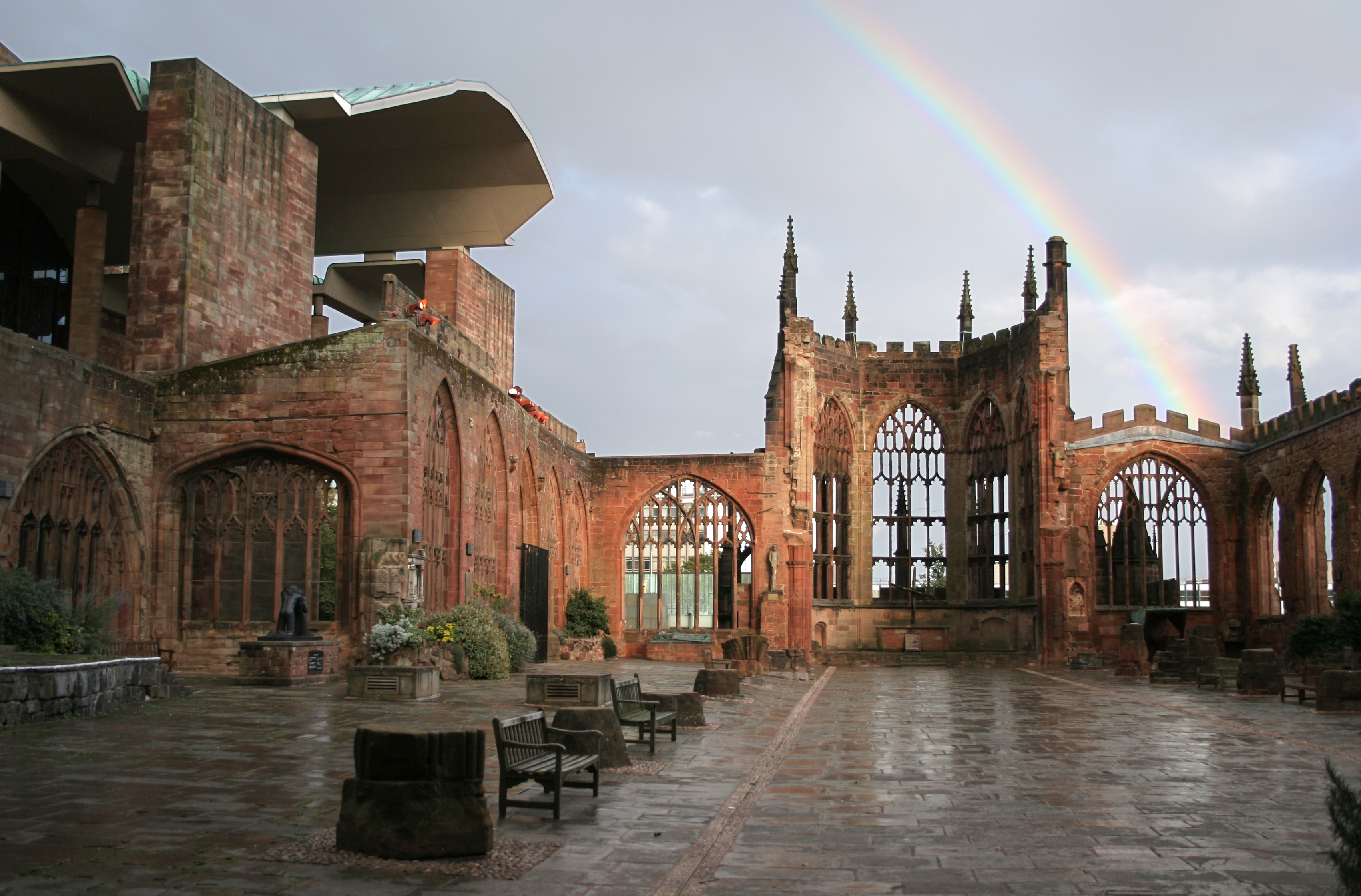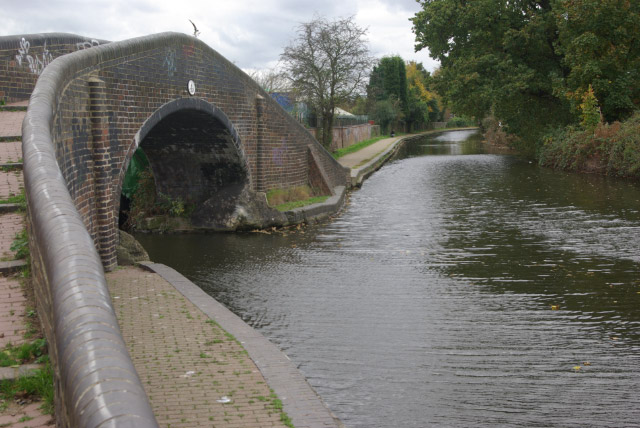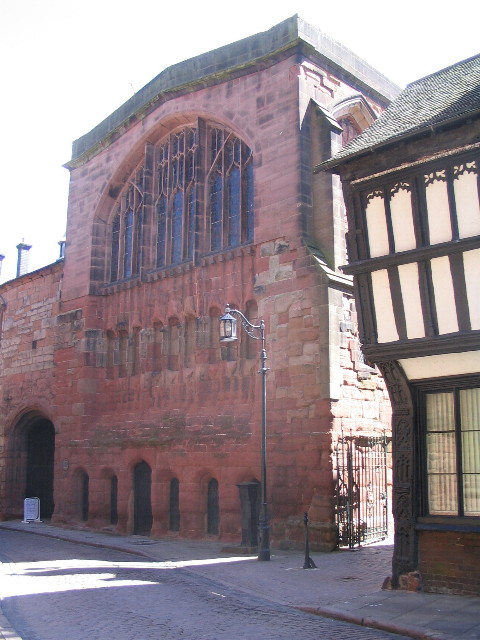|
Caludon
Caludon Castle is a Scheduled Ancient Monument and Grade I listed building in Coventry, in the West Midlands of England. A second moated site to the south is a Scheduled Ancient Monument in its own right. The castle is now a ruin, and all that remains is a large fragment of sandstone wall. What remains of the estate is now an urban park, owned and run by Coventry City Council, but much of it was sold and developed into housing estates in the early 20th century. The site has been occupied since at least the 11th century CE. The original building, pre-dating the Norman conquest of England, was a large house, which became the property of the Earl of Chester after the conquest. The house was given to the Segrave family in the 13th century, and was first described as a manor in 1239. A licence for crenellation was granted in 1305, at which point the house is thought to have been re-styled as a castle. Another licence was received in 1354, and the property was again rebuilt. In ... [...More Info...] [...Related Items...] OR: [Wikipedia] [Google] [Baidu] |
Caludon Castle Diagram
Caludon Castle is a Scheduled Ancient Monument and Grade I listed building in Coventry, in the West Midlands of England. A second moated site to the south is a Scheduled Ancient Monument in its own right. The castle is now a ruin, and all that remains is a large fragment of sandstone wall. What remains of the estate is now an urban park, owned and run by Coventry City Council, but much of it was sold and developed into housing estates in the early 20th century. The site has been occupied since at least the 11th century CE. The original building, pre-dating the Norman conquest of England, was a large house, which became the property of the Earl of Chester after the conquest. The house was given to the Segrave family in the 13th century, and was first described as a manor in 1239. A licence for crenellation was granted in 1305, at which point the house is thought to have been re-styled as a castle. Another licence was received in 1354, and the property was again rebuilt. ... [...More Info...] [...Related Items...] OR: [Wikipedia] [Google] [Baidu] |
Grade I Listed Buildings In Coventry
There are 19 Grade I listed buildings in the City of Coventry. In the United Kingdom, a listed building is a building or structure of special historical or architectural importance. These buildings are legally protected from demolition, as well as from any extensions or alterations that would adversely affect the building's character or destroy historic features. Listed buildings in England and Wales are divided into three categories—Grade II buildings are buildings of special interest; Grade II* buildings are Grade II buildings of particular interest; and Grade I buildings, which are those of "exceptional" interest. Only around four per cent of listed buildings are given Grade I status. Coventry is an ancient city and a metropolitan borough in the West Midlands of England. The city's history dates back to at least the 11th century ( CE), and by the 14th century, it was a thriving centre of commerce. Like many of Coventry's Grade I listed buildings, the city's w ... [...More Info...] [...Related Items...] OR: [Wikipedia] [Google] [Baidu] |
Stephen De Segrave
Stephen de Segrave (or Seagrove or Stephen Segrave or Stephen of Seagrave) (c. 1171 – 9 November 1241) was a medieval Chief Justiciar of England. Life He was born as the son of a certain Gilbert de Segrave of Segrave in Leicestershire, who had been High Sheriff of Warwickshire and Leicestershire in 1193. Stephen became a knight and was made constable of the Tower of London in 1220. He obtained lands and held various positions under Henry III. From 1221 to 1223 he served as High Sheriff of Hertfordshire and Essex, from 1222 to 1224 as High Sheriff of Lincolnshire, from 1228 to 1234 as High Sheriff of Bedfordshire and Buckinghamshire and from 1229 to 1234 as High Sheriff of Warwickshire, Leicestershire and Northamptonshire. In 1236, he became castellan of Beeston Castle and Chester Castle, jointly with Hugh de Spencer and Henry de Aldithley. He was given the manor where Caludon Castle was built, at Wyken near Coventry in 1232 or earlier, by Ranulph de Blondeville, ... [...More Info...] [...Related Items...] OR: [Wikipedia] [Google] [Baidu] |
Wyken
Wyken, a suburb of Coventry, West Midlands, England, is situated between the areas of Stoke and Walsgrave, three miles east-northeast of Coventry city centre. The population of this Coventry Ward taken at the 2011 census was 16,818. It is a fairly large ward spreading as far as the Binley area. The majority of the houses in Wyken are terraced houses. The original parish ran close to the River Sowe and was mainly flat except for Wyken Heath and Wyken Knob near Stoke Heath. History The oldest building within Wyken is Saint Mary Magdalene's Church, located within Wyken Croft, which dates to the early 11th century. The village developed opposite the church and remained a small settlement until the 18th century at which point it began to expand. This original layout has since evolved as Wyken was incorporated into Coventry in 1932 resulting in boundary changes. Wyken became much larger than the original village and in the latest boundary change of 1993, Wyken received Coombe F ... [...More Info...] [...Related Items...] OR: [Wikipedia] [Google] [Baidu] |
Stoke Heath, Coventry
Stoke Heath is a residential area of Coventry, West Midlands, England. It is situated approximately to the north east of the city centre. It borders Courthouse Green to the north, Wyken to the east and Stoke to the south with its western edge demarcated by the A444. History and development The area merited no special mention in medieval records and seems to have been open country and grazing land held by the manors of Wyken and Caludon until the late 17th century. On 3 April 1604 Princess Elizabeth came from Coombe Abbey to Coventry. The Mayor and Aldermen of Coventry met her at "Jabet's Ash on Stoke-green". The civil parish of Stoke Heath, created out of in the west of Wyken in 1920, became part of Coventry in 1928. The city of Coventry's population expanded by 90,000 in 1928 due to significant boundary changes. Prior to that date, the district seems to have been referred to as 'Wyken Heath' or 'Wyken Knob'. A vague reference to a Stoke Common around 1700 being one of t ... [...More Info...] [...Related Items...] OR: [Wikipedia] [Google] [Baidu] |
Coventry
Coventry ( or ) is a city in the West Midlands, England. It is on the River Sherbourne. Coventry has been a large settlement for centuries, although it was not founded and given its city status until the Middle Ages. The city is governed by Coventry City Council. Formerly part of Warwickshire until 1451, Coventry had a population of 345,328 at the 2021 census, making it the tenth largest city in England and the 12th largest in the United Kingdom. It is the second largest city in the West Midlands region, after Birmingham, from which it is separated by an area of green belt known as the Meriden Gap, and the third largest in the wider Midlands after Birmingham and Leicester. The city is part of a larger conurbation known as the Coventry and Bedworth Urban Area, which in 2021 had a population of 389,603. Coventry is east-south-east of Birmingham, south-west of Leicester, north of Warwick and north-west of London. Coventry is also the most central city in Englan ... [...More Info...] [...Related Items...] OR: [Wikipedia] [Google] [Baidu] |
Henry IV Of England
Henry IV ( April 1367 – 20 March 1413), also known as Henry Bolingbroke, was King of England from 1399 to 1413. He asserted the claim of his grandfather King Edward III, a maternal grandson of Philip IV of France, to the Kingdom of France. Henry was the first English ruler since the Norman Conquest, over three hundred years prior, whose mother tongue was English rather than French. Henry was the son of John of Gaunt, Duke of Lancaster, himself the son of Edward III. John of Gaunt was a power in England during the reign of Henry's cousin Richard II. Henry was involved in the revolt of the Lords Appellant against Richard in 1388, resulting in his exile. After John died in 1399, Richard blocked Henry's inheritance of his father's duchy. That year, Henry rallied a group of supporters, overthrew and imprisoned Richard II, and usurped the throne, actions that later would lead to what is termed the Wars of the Roses and a more stabilized monarchy. As king, Henry faced a ... [...More Info...] [...Related Items...] OR: [Wikipedia] [Google] [Baidu] |
Edward I Of England
Edward I (17/18 June 1239 – 7 July 1307), also known as Edward Longshanks and the Hammer of the Scots, was King of England and Lord of Ireland from 1272 to 1307. Concurrently, he ruled the duchies of Duchy of Aquitaine, Aquitaine and Duchy of Gascony, Gascony as a vassal of the French king. Before his accession to the throne, he was commonly referred to as the Lord Edward. The eldest son of Henry III of England, Henry III, Edward was involved from an early age in the political intrigues of his father's reign, which included a rebellion by the English barons. In 1259, he briefly sided with a baronial reform movement, supporting the Provisions of Oxford. After reconciliation with his father, however, he remained loyal throughout the subsequent armed conflict, known as the Second Barons' War. After the Battle of Lewes, Edward was held hostage by the rebellious barons, but escaped after a few months and defeated the baronial leader Simon de Montfort at the Battle of Eve ... [...More Info...] [...Related Items...] OR: [Wikipedia] [Google] [Baidu] |
John De Segrave, 2nd Baron Segrave
John is a common English name and surname: * John (given name) * John (surname) John may also refer to: New Testament Works * Gospel of John, a title often shortened to John * First Epistle of John, often shortened to 1 John * Second Epistle of John, often shortened to 2 John * Third Epistle of John, often shortened to 3 John People * John the Baptist (died c. AD 30), regarded as a prophet and the forerunner of Jesus Christ * John the Apostle (lived c. AD 30), one of the twelve apostles of Jesus * John the Evangelist, assigned author of the Fourth Gospel, once identified with the Apostle * John of Patmos, also known as John the Divine or John the Revelator, the author of the Book of Revelation, once identified with the Apostle * John the Presbyter, a figure either identified with or distinguished from the Apostle, the Evangelist and John of Patmos Other people with the given name Religious figures * John, father of Andrew the Apostle and Saint Peter * Pope John ... [...More Info...] [...Related Items...] OR: [Wikipedia] [Google] [Baidu] |
Carucate
The carucate or carrucate ( lat-med, carrūcāta or ) was a medieval unit of land area approximating the land a plough team of eight oxen could till in a single annual season. It was known by different regional names and fell under different forms of tax assessment. England The carucate was named for the carruca heavy plough that began to appear in England in the late 9th century, it may have been introduced during the Viking invasions of England.White Jr., Lynn, The Life of the Silent Majority, pg. 88 of Life and Thought in the Early Middle Ages, ed. Robert S. Hoyt, University of Minnesota Press, Minneapolis. 1967 It was also known as a ploughland or plough ( ang, plōgesland, "plough's land") in the Danelaw and usually, but not always, excluded the land's suitability for winter vegetables and desirability to remain fallow in crop rotation. The tax levied on each carucate came to be known as "carucage". Though a carucate might nominally be regarded as an area of 120 acres (49 ... [...More Info...] [...Related Items...] OR: [Wikipedia] [Google] [Baidu] |
Nicholas De Segrave, 1st Baron Segrave
Nicholas Segrave, 1st Baron Segrave (also Seagrave; c. 1238 – bef. 12 November 1295) was an English baronial leader. Nicholas was grandson of Stephen de Segrave. Segrave was one of the most prominent baronial leaders during the reign of King Henry III. On 4 August 1265 he was wounded at the Battle of Evesham and taken prisoner, however on the 1st July 1267 he was granted a pardon. In 1295 he was summoned to Parliament to be made a Baron. He died by the 12th November of the same year and was succeeded in the barony by his son John. Marriage and issue Nicholas married Maud de Lucy, daughter of Geoffrey de Lucy, Knt., of Newington in Kent, Cublington, Buckinghamshire, Dallington and Slapton, Northamptonshire, etc., by his wife, Nichole. Nicholas and Matilda 'Maud' had the following issue: *John Segrave, 2nd Baron Segrave, born 1256, died 1325, married Christian de Plescy. * Nicholas Segrave, Knt., was a soldier and administrator, and lord of Stowe in Northamptonshire. From 1 ... [...More Info...] [...Related Items...] OR: [Wikipedia] [Google] [Baidu] |
Justiciar
Justiciar is the English form of the medieval Latin term ''justiciarius'' or ''justitiarius'' ("man of justice", i.e. judge). During the Middle Ages in England, the Chief Justiciar (later known simply as the Justiciar) was roughly equivalent to a modern Prime Minister of the United Kingdom, as the monarch's chief minister. Similar positions existed in continental Europe, particularly in Norman Italy and in the Carolingian Empire. A similar office was formed in Scotland, although there were usually two or three – the Justiciar of Scotia, the Justiciar of Lothian and, in the 13th century, the Justiciar of Galloway. These offices later evolved into a national one called Lord Justice-General. The modern title is Lord President of the Court of Session. The Justiciar of Ireland was an office established during the Anglo-Norman invasion of Ireland and was a key tool in its colonisation. Following the conquest of the Principality of Wales in the 13th century, the areas that becam ... [...More Info...] [...Related Items...] OR: [Wikipedia] [Google] [Baidu] |




